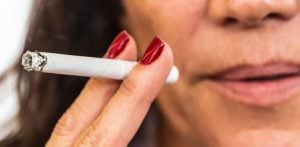“Vape addiction is a big problem at the moment."
The effects of vaping on British youth have become a growing worry, raising concerns about health and addiction. This is also true for British South Asian children and teenagers.
The UK government has launched a 10-year study to investigate the effects of vaping on young people.
The government aims to “tackle youth vaping and create a smoke-free generation.”
The Action on Smoking and Health (ASH) charity found that in 2023, 20.5% of children had tried vaping, up from 15.8% in 2022.
The majority (11.6%) had only vaped once or twice, while 7.6% were currently vaping, and the remainder, 1.3% in 2023, asserted they no longer vape.
With a sharp rise in youth vaping, concerns about long-term health impacts have intensified.
Vaping has become a popular way for people to consume nicotine, marijuana, and other drugs through an electronic device.
Young people may start vaping believing it to be a safer alternative to smoking.
However, there have been warnings that vaping can lead to addiction and other serious health problems for the young.
DESIblitz looks at what the UK government aims to investigate in their study and the vaping issue in the context of the British South Asian community and young people.
Vaping Among British South Asian Youth

In the UK, over a decade or so, vaping quickly became a normalised recreational activity.
Vaping is said to be less harmful than smoking, but not without risk, particularly for people who have never smoked.
Vaping has gained popularity among young people, including British South Asian youth, leading to concerns among parents, health experts and other professionals who work with young people.
Twenty-year-old Danyal* revealed:
“I never did smoke or vape nicotine, so my parents thought it was better than me smoking.
“Vaping looked cool; everyone was and is doing it, loads of flavours.
“I didn’t think it was a big deal when I started at 15, and now it’s a habit.”
Social acceptance, accessibility, and marketing strategies contribute to the popularity of vapes.
Many believe vaping is less harmful than smoking, but research suggests potential risks to lung health and cognitive development.
The easy availability of flavoured vape products makes them particularly attractive to younger users.
Razia’s daughter and son both started vaping when they were underage teenagers:
“I wasn’t happy and tried to get them to stop, but thought it safe and not dangerous like smoking.
“And I didn’t learn until late that they could get drugs in the vape things. WW3 started in the house when I did.”
Many South Asian households discourage traditional smoking but are less aware of the dangers of vaping.
Lack of awareness can allow young people to experiment with vaping, often without understanding its long-term consequences.
Addressing this issue requires targeted education campaigns to inform young people and parents about the hidden dangers of vaping.
Vaping and Addiction in South Asian Young People

Vaping devices are used to consume substances like nicotine, THC (tetrahydrocannabinol, a chemical found in cannabis), and synthetic cannabinoids.
Thus, usage raises further concerns about addiction and mental health risks among young users.
Gangs and youth violence specialist Khalid Hussain, the founder of Kal’s Community Projects (KCP), told DESIblitz:
“Vape addiction is a big problem at the moment.
“We need to address it in the Asian community with our kids.
“A lot of the kids are getting exploited.
“Gangs will target vulnerable kids, like those at the referral schools, those with disability money and charge them £10 for vape juices with like THC in it.
“There a some serious chemicals in these vapes that can mess the brain up, that cause seizures, I’ve seen it happen.”
For Khalid (also known as Kal), the community and family play a vital role in intervention and prevention.
He is a firm believer that young people but also parents and the community as a whole need to be educated on the realities of the dangerous substances found in “vape juices”.
Many South Asian families discourage smoking, but vaping is often seen as a lesser evil. This perception can lead to higher acceptance, making it easier for young people to develop a habit and use illicit substances.
The lack of open discussions about substance use in many South Asian households prevents early intervention.
Increased awareness and support programs can help address this growing issue within the community.
Decade-Long Government Investigation

The UK government are focused on investigating how vaping impacts the health and wellbeing of young people.
The government have stated:
“While vaping is less harmful than smoking and can be a useful tool to help adult smokers quit, youth vaping has skyrocketed in recent years, with a quarter of 11 to 15-year-olds having tried it.”
The £62 million UK government research project into adolescent health will track 100,000 young people aged eight to 18. It is funded by UK Research and Innovation.
Data on behaviour, biology, and health records will be collected to understand how vaping affects young people’s health and well-being.
The study is one of three pieces of government-commissioned research. It comes alongside the launch of England’s first-ever public health marketing campaign to educate children on the harms of vaping.
The outcome of the 10-year-long study will likely shape future legislation and public health initiatives.
The World Health Organisation (WHO) has urged governments to treat e-cigarettes (vaping) similarly to tobacco, warning of their health impact and potential to drive nicotine addiction among non-smokers, especially children and young people.
Sarah Sleet, Chief Executive at Asthma + Lung UK, said:
“The number of non-smokers, particularly young people, taking up vaping is extremely worrying.”
“The long-term impact of vaping on the lungs isn’t yet known, so research into its effect on young people is really important.”
By tackling youth vaping, the UK government aims to protect young people’s health while reducing the long-term burden on the healthcare system.
The Health Risks of Vaping
The effects of vaping on children/young people are still under investigation. However, existing studies highlight several concerns:
- Addiction: Vaping products often contain nicotine, leading to dependence; other addictive substances can also be purchased in vape liquids.
- Respiratory issues: Chemicals in vapes may cause lung irritation and long-term damage
- Cognitive development: For example, nicotine affects brain function in young users
- Heart health risks: Some studies suggest vaping can increase heart rate and blood pressure
- Exposure to harmful chemicals: Vape liquids may contain toxic substances that harm lung tissue
- Potential gateway to smoking: Some research indicates young vapers can transition to traditional cigarettes over time
- Mental health concerns: Including depression, anxiety and psychosis
In the UK, it is illegal to sell any vape to anyone under 18. However, young people have been getting access.
Disposable vapes, often sold in smaller, more colourful packaging than refillable ones, have been seen as a “key driver behind the alarming rise in youth vaping”, as stated by the previous Tory government.
From June 1, 2025, disposable vapes will be banned, and their sale online and in-store will be illegal.
The ban is expected to reduce their accessibility and appeal to young people.
The Tobacco and Vapes Bill, part of the government’s Plan for Change, includes plans to strengthen enforcement to prevent underage sales and stop illicit vaping products from reaching the market.
The government aim to limit the flavours and packaging that can be used, as well as displays deliberately designed to appeal to children.
However, there are concerns that young people will still get access.
The effects of vaping on children and teenagers are a growing concern.
The UK government’s study is a step forward, but collective efforts are needed to protect young people from the risks of vaping.
Increased education and stricter regulations can possibly help curb the rise in youth vaping.
In turn, there is a need to raise awareness within communities and families about the realities of vaping and what can occur.
The findings of the government study will play a key role in shaping future policies to protect children’s and young people’s health and well-being.
The question is, in a decade, what consequences will we see due to the normalisation of vaping, and is a future public health crisis inevitable?






























































